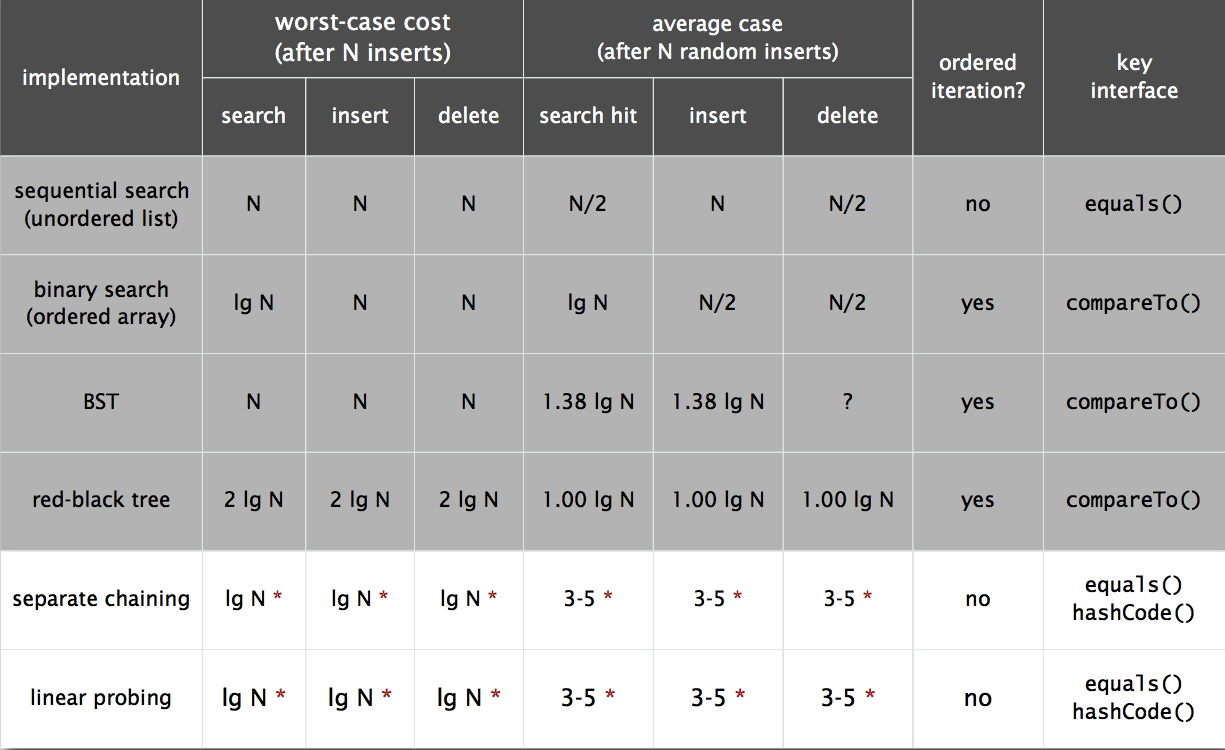Hash tables
Save items in a key-indexed table (index is a function of the key).
Hash function: Method for computing array index from key.
All Java classes inherit a method hashcode(), which returns a 32-bit integer.
If x.equals(y), then x.hashCode() == y.hashCode() and vice versa.
Hash code: An int between and
Hash function: An int between 0 and M-1 (for user as array index)
private in hash(Key key)
{ return (key.hashCode() & 0x7fffffff) % M;}
// get the absolute value first then remainder
Separate Chaining
Separate chaining ST using linked list
For every hash, make a linked list to store the key and value
Make constant time ops.
Linear Probing
Insert: Put at table index i if free; if not try i+1, i+2, etc.
Search: Search table index i; if occupied but no match, try i+1, i+2, etc.
Array size M must be greater than number of key-value pairs N.
Works well when size of the array is significantly bigger than the number of keys.
Hash Table Context

- Simple to code
- Faster for simple keys
- Better system support in Java for strings
java.util.HashMap
java.util.IdentityHashMap
Balanced search trees
- Stronger performance guarantee
- Support for ordered ST operations
- Easier to implement
compareTo()correctly thanequals()andhashCode()
java.util.TreeMap
java.util.TreeSet
Applications
Mathematical Sets
Dictionary Clients
Indexing Clients
public class Concordance
{
public static void main(String[] args)
{
In in = new In(args[0]);
String[] words = in.readAllStrings();
ST<String, SET<Integer>> st = new ST<String, SET<Integer>>();
for (int i = 0; i < words.length; i++)
{
String s = words[i];
if (!st.contains(s))
st.put(s, new SET<Integer>());
SET<Integer> set = st.get(s);
set.add(i);
}
while (!StdIn.isEmpty())
{
String query = StdIn.readString();
SET<Integer> set = st.get(query);
for (int k : set)
}
}
}
Sparse Vectors
public class SparseVector
{
private HashST<Integer, Double> v;
public SparseVector()
{ v = new HashST<Integer, Double>(); }
public void put(int i, double x)
{ v.put(i, x); }
public double get(int i)
{ if (!v.contains(i)) return 0.0;
else return v.get(i);
}
public Iterable<Integer> indices()
{ return v.keys(); }
public double dot(double[] that)
{
double sum = 0.0;
for (int i : indices())
sum += that[i]*this.get(i);
return sum;
}
}
